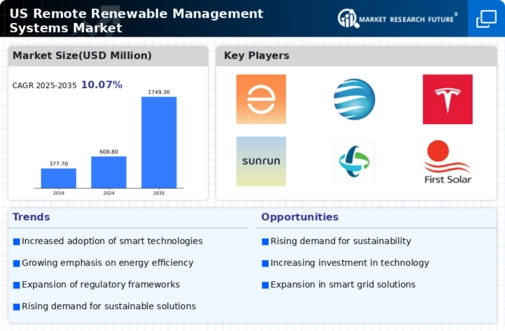The competitive landscape of the US Remote Renewable Management Systems Market showcases a sector poised for significant transformation, driven by advancements in technology and a growing emphasis on sustainability. This market comprises various stakeholders, including technology providers, energy companies, and utilities, all vying for market share as the demand for efficient renewable energy management solutions rises. With a strong focus on optimizing the integration of renewable energy sources into the grid, companies are leveraging innovative systems that facilitate remote monitoring, control, and data analytics.
This burgeoning market reflects not only the growth of renewable energies like solar and wind but also the need for systems that manage these resources effectively, ensuring reliability and efficiency. As regulations evolve and consumers become more environmentally conscious, competition will likely intensify, prompting players to innovate and differentiate their offerings to capture a larger share of this emerging market.Enphase Energy has established itself as a formidable player in the US Remote Renewable Management Systems Market, primarily known for its robust energy management technology.
The company specializes in providing solutions that optimize solar energy generation and consumption, utilizing its advanced microinverter technology to enhance system performance while ensuring grid stability. Enphase Energy's proprietary software platforms enable real-time monitoring and analytical insights, which empower both residential and commercial users to maximize the value of their energy systems. The company's commitment to innovation is reflected in its continuous enhancements to its product offerings, focusing on user-friendly interfaces and seamless integration with various energy sources.
Furthermore, its strong distribution network and brand reputation strengthen its presence in the market, allowing it to maintain a competitive edge in an increasingly crowded landscape.Statkraft, recognized as a key player in the US Remote Renewable Management Systems Market, focuses on developing and managing hydropower generation technologies alongside emerging renewable solutions. The company’s expertise extends to offering comprehensive energy management services that utilize data analytics and forecasting to optimize operations and enhance efficiency. Statkraft provides an array of services, including energy portfolio management, real-time monitoring, and grid support solutions, which are crucial in managing renewable energy's inherent variability.
Its strategic approach includes partnerships with regional utilities and investment in innovative technologies aimed at enhancing grid flexibility and reliability. With several mergers and acquisitions that bolster its presence in the US market, Statkraft is positioned to leverage its extensive experience and technological capabilities in delivering reliable renewable energy solutions. The integration of sustainable practices within its operations and commitment to reducing carbon footprints contribute to its standing as a leader in the sector.






















